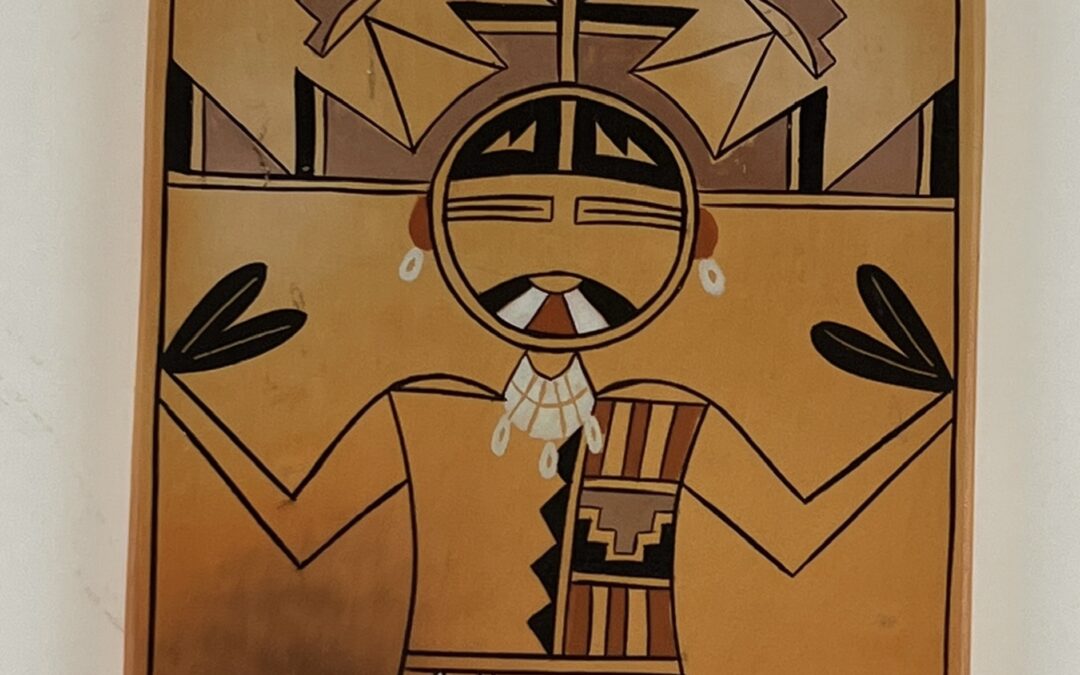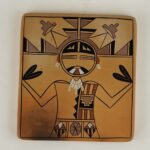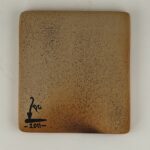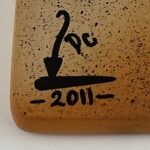This collection contains about a dozen versions of the Polik’Mana, from a tile (2014-10) and a tray (2017-04) by Nampeyo, to modern tiles (cf 2017-03), canteens, vases, a corn meal bowl, and even an image painted on cloth but posing as a tile (2016-02). The format of these images is fairly standardized. Nevertheless, within this grouping, tile 2023-11is particularly precisely painted, extensively uses an unusual color, and is highlighted by unpainted space around it. That’s a pleasing combination by an artist who had only been working as a potter for a year or two when she made this tile.
Form:
The tile is rectangular, just a fraction of an inch taller than it is wide; its corners are slightly rounded. The painted surface is not quite flat; the back side is flatter. The tile is quite thick for its size. A firing cloud, where the dung fuel probably touched its surface, mars the lower left corner of the tile and continues on its edge and backside. The tile is signed “DC” with a tobacco pipe representing Debbie’s clan and the date of production, 2011.
Design:
The Polik’Mana dancer can have either female or male personas. Female identity is indicated by a large red dot on the cheeks (cf 2019-03); male identity is indicated by a striated triangle on the cheeks (cf 2021-13). Unusually Debbie’s rendition carries no design on its cheek and quite arbitrarily I will refer to this image as a female.
On this tile the Mana stands erect directly facing the viewer. Dance tabulas are built on a framework and here that framework is represented by two parallel black lines (“one-lane highways”) that support both the vertical and horizontal elements. Attached to this structure is a mauve-colored yoke supporting multiple mauve triangles that display a one-lane highway topped by a black stripe along one edge. The vertical section of the tabula displays two pairs of these triangles, black strip facing up. The horizontal section of the tabula displays two triangles on either side of the head, black stripes oriented away from the face. Set on the rounded section of the yoke between the vertical and horizontal elements, on either side of the face, Debbie has drawn unpainted, black-edged triangles. Each of these triangles is topped with a three-stepped mauve cloud image and each has a wide, low, and unpainted hill in their base.
The Mana’s face is formed by two concentric black circles a fraction of an inch apart, a circular “one-lane highway,” if you like that moniker. Her forehead occupies the upper third of the face and is painted black, except that it is bisected by a thin, unpainted line and each side contains a pair of unpainted, conjoint right triangles pointing towards the edges of the face. Below are two slit eyes outlined in black, the standard treatment of the eyes when the Polik’Mana is drawn on pottery. Below is a small half-moon mouth with 5 rays of color emerging from it. The central ray is red and is bordered by white elements while the rays along the edge of the mouth are black. Her ears are just below the tabula and are small red lunettes. From each hangs a white loop, probably shell-bead earrings. Little of her neck can be seen, since most of this area is covered by a necklace of ten white plaques in two rows. From their lower edge hang three additional white loops.
Slight areas of her shoulders can be seen and these extend to arms with bent elbows, simply outlined in black without much other form or detail. Hands are not shown. Just beyond the edge of the tile, in each hand, the Mana holds two black prayer feathers, which are clearly shown on the tile.
The Mana’s torso is partially covered with a vertical sash and a horizontal kilt, with most of her upper-left torso (viewer’s orientation) left bare. A horizontal one-lane highway marks her waist. Rising from its center is another one-lane highway that disappears under her necklace. To the left of this vertical line a string of four isosceles triangles point left. The right side of her torso is draped with an elaborate textile carrying three rectangles of design separated by more one-lane highways. The top and bottom rectangles have five stripes of color, three red alternating with two unpainted stripes. The center rectangle features a mauve, stepped rain cloud hanging down with the resulting residual space below filled with black stepped forms that also suggest rain. Between the mauve and black elements is a narrow unpainted space that is constrained into having 5 steps such that all three elements in this rectangle suggest rain.
Only the top of the kilt below her waist is visible and this fabric is also divided into three sections with the first and last being identical and the center rectangle being unique. The central section contains a mauve octagon internally divided into eight wedges. Flanking it are rectangles containing a complex diamond. Its lower half shows 7 unpainted and black stripes alternating . Above, the residual triangle has a small white diamond at its apex, the space below forming two triangles. The left triangle is painted red, the right is stippled with black paint.
Design Analysis:
Because Debbie simplified the structure of the tabula and left considerable unpainted space around the figure, her depiction of the Polik’Mana has a particularly clean and elegant look. Shoulders and arms are simply depicted in plain outline without detail. Hands are not shown at all, perhaps because hands are notoriously difficult to draw and at the start of her career Debbie did not want to attempt drawing them. Then again, Nampeyo’s depictions of this figure (noted in the first line of this entry) show either a simple black dot for hands or add a circle of bent lines that look most like claws.
Design elements are repeated across the full expanse of the Polik’Mana, thus integrating the design. The two pairs of small unpainted triangles in the forehead echo the ten triangles in the tabula above. This triangular pattern is continued with the vertical string of 4 black triangles on her chest and the two diamond shapes on her kilt. On the kilt, the small white diamond at the peak of the larger diamond shape in which it is embedded subtly reinforces this shape in the viewer’e eye. Stepped cloud elements are drawn on both sides of the tabula and one is shown on the Mana’s torso. This repetition of forms visually links disparate sections of design.
The vertical sash and horizontal kilt on the Mana have very different designs, but their pattern of design is the same: on both the first and last squares have the same design while the middle design is unique. Both also have an expanse of mauve in the central square. Furthermore, the stripes that dominate the vertical sash are reflected in the stripes on the lower half of the diamonds on the kilt. These similarities link and harmonize the two cloths.
The middle square of the vertical torso drape shows foreground/background reversal, and this alternating pattern of rain clouds energizes the design as a viewer’s eyes shift between equally-possible patterns.
Color (other than black) on pottery from Hopi is created by creating a slip of natural clay, applying it to a pot, and then firing the pot. The natural color of the clay is generally very different than its fired color. Yellow clay, for example, fires red. Towards the end of his career Mark Tahbo discovered an unusual clay that fired mauve. He used this color sparingly on his pots (2014-12 and 2018-01). Mark mentored Debbie and I assume he was the source of the mauve color seen in abundance on tile 2023-11. Debbie used this rare color to integrate the design since it appears at the top, middle and lower sections of the Mana.
In short, the design of the Polik’Mana on tile 2023-11 is somewhat simplified and highlighted by unpainted space that surrounds it, which emboldens the image. It carries a sophisticated internal structure of elements that integrates the design while the extensive use of the rare mauve color delights the eye. This is a notable achievement for a talented artist at the start of her career.




